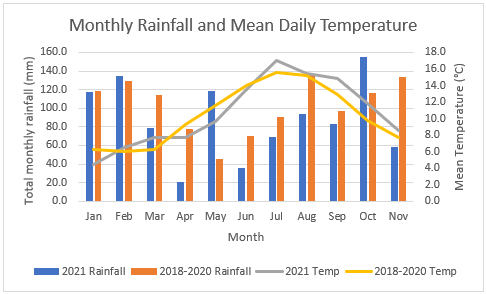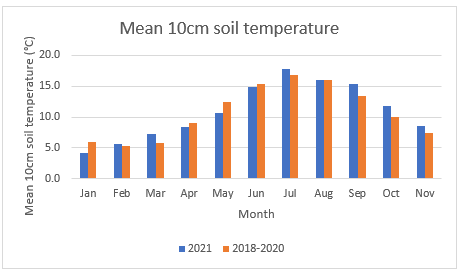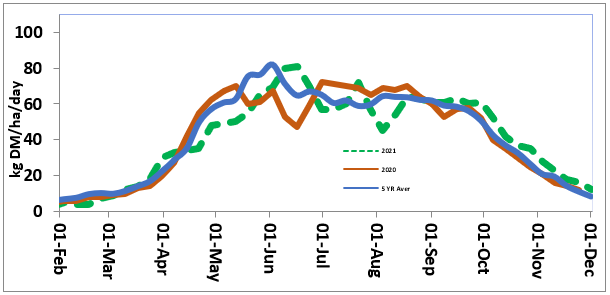Although many of us will look back on 2021 and consider it a good year for grass growth, it was not without its challenges. Germinal’s Technical Development Manager, Dr Mary McEvoy looks back at this year’s weather and growth patterns and what it means as 2021 draws to a close.
Last April, a cold dry spell meant conditions on farm were ideal for achieving good clean outs and, for many farms, made the month simpler than usual in terms of achieving target grazing residuals. Average rainfall for the three sites in Figure 1 was 35mm lower in March than the average of the three previous years, and 57mm less in April. An average April soil temperature of 8.4°C also meant growth was lower than usual for the time of year (Figure 2).

Figure 1. Monthly rainfall and mean daily temperature averaged across three sites: Valentia Observatory, Gurteen and Ballyhaise. Source: Met Eireann, 2021

Figure 2. Monthly soil temperature averaged across three sites: Valentia Observatory, Gurteen and Ballyhaise. Source: Met Eireann, 2021
Conditions became far more challenging in May, with rainfall 262% higher than the previous three-year average. Combined with an air temperature 2°C below average and a soil temperature 1.7°C below average, grass growth remained slow and was extremely poor for May.
Data from PastureBase Ireland reflects this, clearly demonstrating a dramatic reduction in grass growth from mid-April until June (Figure 3). Daily grass growth rates in May were 10-15kg DM/ha lower than the 5-year average, creating a substantial deficit on farms at a time when silage was front of mind.

Figure 3. Average rate of grass growth for 2020, 2021 and the 5-year average. Source: PastureBase Ireland
This left peak grass growth a month behind normal, with most farms seeing peak growth in mid-June. Summer grass quality was compromised on many farms, with stemmy poor quality grass further impacting cleanouts up until August.
Dry autumn conditions
Conditions finally picked up in the latter part of the season. Autumn proved ideal on most farms, with above-average temperatures and adequate rainfall maintaining grass growth well into the backend of the year. Unusually, grass growth this year was higher on most farms in September than in May and remained at 20-40kg DM/ha/day into the second half of October.
A drier than usual November allowed most farms to use the grass grown in autumn. With ground conditions remaining good, and above-average soil temperatures, grass growth remained reasonable on-farm.
If not already completed, now is a good time to finish closing covers to prevent jeopardising next spring’s grass availability. It also allows you to determine total production per paddock for the year and make an accurate calculation of growth over winter when combined with an opening cover next spring.
Whatever 2022’s weather has in store for us, we know new grasses, with access to the latest genetics, perform better. And with input costs expected to remain high, you need high-achieving swards in the ground. As you make plans for reseeding in 2022, look at which grass varieties are best for your system.
Ask out forage specialists
